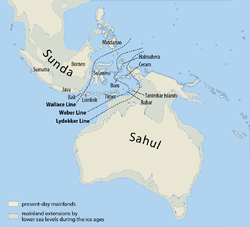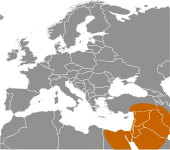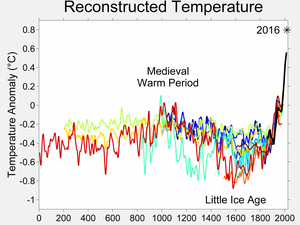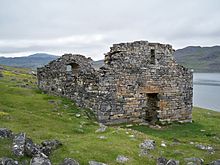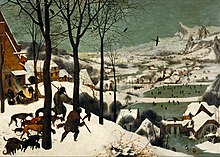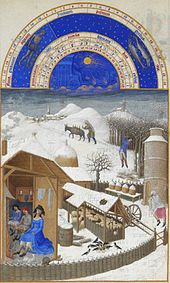Knowledge of early human migrations, a major topic of archeology, has been achieved by the study of human fossils, occasionally by stone-age artifacts and more recently has been assisted by archaeogenetics. Cultural and ethnic migrations are estimated by combining archaeogenetics and comparative linguistics.
Early humans (before Homo sapiens)

A reconstruction of Homo erectus. Anthropologists believe that H. erectus was the first hominid to control fire (reconstruction shown in Westfälisches Landesmuseum, Herne, Germany, in a 2006 exhibition).
Homo erectus migrated from out of Africa via the Levantine corridor and Horn of Africa to Eurasia during the Early Pleistocene, possibly as a result of the operation of the Saharan pump, around 1.9 million years ago, and dispersed throughout most of the Old World, reaching as far as Southeast Asia. The date of original dispersal beyond Africa virtually coincides with the appearance of Homo ergaster in the fossil record, and about half a million years after the appearance of the Homo genus itself and the first stone tools of the Oldowan industry. Key sites for this early migration out of Africa are Riwat in Pakistan (~2 Ma?[1]), Ubeidiya in the Levant (1.5 Ma) and Dmanisi in the Caucasus (1.81 ± 0.03 Ma, p = 0.05[2]).
China was populated as early as 1.66 Mya based on stone artifacts found in the Nihewan Basin.[3] The archaeological site of Xihoudu (西侯渡) in Shanxi Province is the earliest recorded use of fire by Homo erectus, which is dated 1.27 million years ago.[4]
Southeast Asia (Java) was reached about 1.7 million years ago (Meganthropus). Western Europe was first populated around 1.2 million years ago (Atapuerca).[5]
Robert G. Bednarik has suggested that Homo erectus may have built rafts and sailed oceans, a theory that has raised some controversy.[6]
The expansion of H. erectus was followed by the arrival of H. antecessor in Europe around 800,000 years ago, which was in turn followed by migration from Africa to Europe of H. heidelbergensis, the likely ancestor of both modern humans and Neanderthals, around 600,000 years ago.[7]
Homo sapiens migrations
Map of Y-chromosome haplogroups.
Homo sapiens seems to have appeared in East Africa around 200,000 years ago. The oldest individuals found left their marks in the Omo remains (195,000 years ago) and the Homo sapiens idaltu (160,000 years ago), that was found at the Middle Awash site in Ethiopia.[8]
When modern humans reached the Near East 125,000 years ago, evidence suggests they retreated back to Africa, as their settlements were replaced by Neanderthals[citation needed][9]. It is now believed that the first modern humans to spread east across Asia left Africa about 75,000 years ago across the Bab el Mandib connecting Ethiopia and Yemen.[10] From the Near East, some of these people went east to South Asia by 50,000 years ago, and on to Australia by 46,000 years ago at the latest,[11] when for the first time H. sapiens reached territory never reached by H. erectus. H. sapiens reached Europe around 43,000 years ago,[12] eventually replacing the Neanderthal population by 40,000 years ago.[13] East Asia was reached by 30,000 years ago. Archaeological and genetic data suggest that the source populations of Paleolithic humans survived in sparsely wooded areas and dispersed through areas of high primary productivity while avoiding dense forest cover.[14] The date of migration to North America, and whether humans had previously inhabited the Americas is disputed; it may have taken place around 30 thousand years ago, or considerably later, around 14 thousand years ago. The oldest radiocarbon dated carbonized plant remains were determined to be 50,300 years old and were discovered at the Topper site in Allendale South Carolina in May 2004 alongside stone tools similar to those of pre-Clovis era humans.[15] The oldest DNA evidence of human habitation in North America however, has been radiocarbon dated to 14,300 years ago, and was found in fossilized human coprolites uncovered in the Paisley Five Mile Point Caves in south-central Oregon.[16] Colonization of the Pacific islands of Polynesia began around 1300 BC, and was completed by 1280 AD (New Zealand). The ancestors of Polynesians left Taiwan around 5,200 years ago.
More recent migrations of language and culture groups within the modern species are also studied and hypothetised. The African Epipaleolithic Kebaran culture is believed to have reached Eurasia about 18,000 years ago, introducing the bow and arrow to the Middle East, and may have been responsible for the spread of the Nostratic languages. The people of the Afro-Asiatic language family seem to have reached Africa in 6,200 BC, introducing the Semitic languages to the Middle East.
From there they spread around the world. An initial venture out of Africa 125,000 years ago was followed by a flood out of Africa via the Arabian Peninsula into Eurasia around 60,000 years ago, with one group rapidly settling coastal areas around the Indian Ocean and one group migrating north to steppes of Central Asia.[17]
There is evidence from mitochondrial DNA that modern humans have passed through at least one genetic bottleneck, in which genome diversity was drastically reduced. Henry Harpending has proposed that humans spread from a geographically restricted area about 100,000 years ago, the passage through the geographic bottleneck and then with a dramatic growth amongst geographically dispersed populations about 50,000 years ago, beginning first in Africa and thence spreading elsewhere.[18] Climatological and geological evidence suggests evidence for the bottleneck. The explosion of Lake Toba created a 1,000 year cold period, as a result of the largest volcanic eruption of the Quaternary, potentially reducing human populations to a few tropical refugia. It has been estimated that as few as 15,000 humans survived. In such circumstances genetic drift and founder effects may have been maximised. The greater diversity amongst African genomes may be in part due to the greater prevalence of African refugia during the Toba incident.[19]
Within Africa
The most recent common ancestor shared by all living human beings, dubbed Mitochondrial Eve, probably lived roughly 120–150 millennia ago,[20] the time of Homo sapiens idaltu, probably in East Africa.[citation needed]The broad study of African genetic diversity headed by Dr. Sarah Tishkoff found the San people to express the greatest genetic diversity among the 113 distinct populations sampled, making them one of 14 "ancestral population clusters." The research also located the origin of modern human migration in south-western Africa, near the coastal border of Namibia and Angola.[21]
Around 100,000-80,000 years ago, three main lines of Homo sapiens diverged. Bearers of mitochondrial haplogroup L0 (mtDNA) / A (Y-DNA) colonized Southern Africa (the ancestors of the Khoisan ( peoples), bearers of haplogroup L1 (mtDNA) / B (Y-DNA) settled Central and West Africa (the ancestors of western pygmies), and bearers of haplogroups L2, L3, and others mtDNA remained in East Africa (the ancestors of Niger–Congo- and Nilo-Saharan-speaking peoples).
Exodus from Africa

Red sea crossing.
There is some evidence for the argument that modern humans left Africa at least 125,000 years ago using two different routes: the Nile Valley heading to the Middle East, at least into modern Israel (Qafzeh: 120,000–100,000 years ago); and a second one through the present-day Bab-el-Mandeb Strait on the Red Sea (at that time, with a much lower sea level and narrower extension), crossing it into the Arabian Peninsula, settling in places like the present-day United Arab Emirates (125,000 years ago)[22] and Oman (106,000 years ago)[23] and then possibly going into the Indian Subcontinent (Jwalapuram: 75,000 years ago). Despite the fact that no human remains have yet been found in these three places, the apparent similarities between the stone tools found at Jebel Faya, the ones from Jwalapuram and some African ones suggest that their creators were all modern humans.[24] These findings might give some support to the claim that modern humans from Africa arrived at southern China about 100,000 years ago (Zhiren Cave, Zhirendong, Chongzuo City: 100,000 years ago;[25] and the Liujiang hominid (Liujiang County): controversially dated at 139,000–111,000 years ago [26]). Dating results of the Lunadong (Bubing Basin, Guangxi, southern China) teeth, which include a right upper second molar and a left lower second molar, indicate that the molars may be as old as 126,000 years.[27]
Since these previous exits from Africa did not leave traces in the results of genetic analyses based on the Y chromosome and on MtDNA (which represent only a small part of the human genetic material), it seems that those modern humans did not survive or survived in small numbers and were assimilated by our major antecessors. An explanation for their extinction (or small genetic imprint) may be the Toba catastrophe theory (74,000 years ago). However, some argue that its impact on human population was not dramatic.[28]
According to the Recent African Origin theory a small group of the L3 Haplogroup bearers living in East Africa migrated north east, possibly searching for food or escaping adverse conditions, crossing the Red Sea about 70 millennia ago, and in the process going on to populate the rest of the world. According to some authors, based in the fact that only descents of L3 are found outside Africa, only a few people left Africa in a single migration to a settlement in the Arabian peninsula.[29] From that settlement, some others point to the possibility of several waves of expansion close in time.
South Asia and Australia
Dating of teeth from China provides evidence of an early migration of modern humans from Africa into Southeast Asia before 80,000 - 120,000 years ago.[30]The later major migration from Africa traveled along the coast of Arabia and Persia to India and the rest of South Asia. Along the way H. sapiens interbred with Neanderthals and Denisovans,[31] with Denisovan DNA making 0.2% of mainland Asian and Native American DNA.[32] David Reich of Harvard University and Mark Stoneking of the Planck Institute team, found genetic evidence that Denisovan ancestry is shared by Melanesians, Australian Aborigines, and smaller scattered groups of people in Southeast Asia, such as the Mamanwa, a Negrito people in the Philippines suggesting the interbreeding took place in Eastern Asia where the Denisovans lived.[33][34][35] Denisovans may have crossed the Wallace Line, with Wallacea serving as their last refugium.[36][37] Homo erectus crossed the Lombok gap reaching as far as Flores, but never made it to Australia.[38]
The map shows the probable extent of land and water at the time of the last glacial maximum, 20,000 yrs ago and when the sea level was probably more than 110m lower than today.
During this time sea level was much lower and most of Maritime Southeast Asia formed one land mass known as Sunda. Migration continued Southeast on the coastal route to the straits between Sunda and Sahul, the continental land mass of present-day Australia and New Guinea. The gaps on the Weber Line are up to 90 km wide,[39] so the migration to Australia and New Guinea would have required seafaring skills. Migration also continued along the coast eventually turning northeast to China and finally reaching Japan before turning inland. This is evidenced by the pattern of mitochondrial haplogroups descended from haplogroup M, and in Y-chromosome haplogroup C.
Sequencing of one Aboriginal genome from an old hair sample in Western Australia, revealed that the individual was descended from people who migrated into East Asia between 62,000 and 75,000 years ago. This supports the theory of a single migration into Australia and New Guinea before the arrival of Modern Asians (between 25,000 to 38,000 years ago) and their later migration into North America.[40] This migration is believed to have happened around 50,000 years ago, before Australia and New Guinea were separated by rising sea levels approximately 8,000 years ago.[41][42] This is supported by a date of 50,000 - 60,000 years ago for the oldest evidence of settlement in Australia,[11][43] around 40,000 years ago for the oldest human remains[11] and the extinction Australian megafauna by humans between 46,000 and 15,000 years ago advocated by Tim Flannery,[44] which is similar to what happened in the Americas. The continued use of stone age tools in Australia has been much debated.[45]
Europe
Europe is thought to have been colonized by northwest-bound migrants from Central Asia and the Middle East, as a result of cultural adaption to big game hunting of sub-glacial steppe fauna.[46] When the first anatomically modern humans entered Europe, Neanderthals were already settled there. Debate exists whether modern human populations interbred with Neanderthal populations, most of the evidence suggesting that it happened to a small degree rather than complete absorption. Populations of modern humans and Neanderthal overlapped in various regions such as in Iberian peninsula and in the Middle East. Interbreeding may have contributed Neanderthal genes to palaeolithic and ultimately modern Eurasians and Oceanians.An important difference between Europe and other parts of the inhabited world was the northern latitude. Archaeological evidence suggests humans, whether Neanderthal or Cro-Magnon, reached sites in Arctic Russia by 40,000 years ago.[47]
Around 20,000 BC, approximately 5,000 years after the Neanderthal extinction, the Last Glacial Maximum took place, forcing northern hemisphere inhabitants to migrate to several shelters (known as refugia) until the end of this period. The resulting populations, whether interbred with Neanderthals or not, are then presumed to have resided in those hypothetical refuges during the LGM to ultimately reoccupy Europe where archaic historical populations are considered their descendants. An alternate view is that modern European populations have descended from Neolithic populations in the Middle East that have been well documented in this area. The debate surrounding the origin of Europeans has been worded in terms of cultural diffusion versus demic diffusion.[citation needed] Archeological evidence and genetic evidence strongly support demic diffusion, that a population spread from the Middle East over the last 12,000 years.[citation needed] A scientific genetic concept called the Time to Most Recent Common Ancestor or TMRCA has been used to refute the demic diffusion in favour of cultural diffusion.[48]
Migration of the Cro-Magnons into Europe
Cro-Magnon are considered the first anatomically modern humans in Europe. They entered Eurasia by the Zagros Mountains (near present-day Iran and eastern Turkey) around 50,000 years ago, with one group rapidly settling coastal areas around the Indian Ocean and one group migrating north to steppes of Central Asia.[17] Modern human remains dating to 43-45,000 years ago have been discovered in Italy[49] and Britain,[50] with the remains found of those that reached the European Russian Arctic 40,000 years ago.[51][52]Humans colonised the environment west of the Urals, hunting reindeer especially,[53] but were faced with adaptive challenges; winter temperatures averaged from −20 to −30 °C (−4 to −22 °F) while fuel and shelter were scarce. They travelled on foot and relied on hunting highly mobile herds for food. These challenges were overcome through technological innovations: production of tailored clothing from the pelts of fur-bearing animals; construction of shelters with hearths using bones as fuel; and digging of “ice cellars” into the permafrost for storing meat and bones.[53][54]
A mitochondrial DNA sequence of two Cro-Magnons from the Paglicci Cave in Italy, dated to 23,000 and 24,000 years old (Paglicci 52 and 12), identified the mtDNA as Haplogroup N, typical of the latter group.[55] The inland group is the founder of both North- and East Asians, Caucasoids and large sections of the Middle East population. Migration from the Black Sea area into Europe started sometime around 45,000 years ago, probably across the Bosphorus and along the Danubian corridor. By 20,000 years ago, the whole of Continental Europe had been settled.
Migration of modern humans into Europe, based on simulation by Currat & Excoffier (2004)[56] (YBP=Years before present)
Competition with Neanderthals
The expansion of modern human population is thought to have begun 45,000 years ago, and may have taken 15,000-20,000 years for Europe to be colonized.[57][58]During this time the Neanderthals were slowly being displaced. Because it took so long for Europe to be occupied, it appears that humans and Neanderthals may have been constantly competing for territory. The Neanderthals had larger brains, and were larger overall, with a more robust or heavily built frame, which suggests that they were physically stronger than modern Homo sapiens. Having lived in Europe for 200,000 years, they would have been better adapted to the cold weather. The anatomically modern humans known as the Cro-Magnons, with widespread trade networks, superior technology and bodies likely better suited to running, would eventually completely displace the Neanderthals, whose last refuge was in the Iberian peninsula. After about 25,000 years ago the fossil record of the Neanderthals ends, indicating that they had become extinct. The last known population lived around a cave system on the remote south-facing coast of Gibraltar from 30,000 to 24,000 years ago.
A 2010 study of Neanderthal genes and modern human genes concluded that interbreeding took place between Neanderthals and Homo sapiens sapiens between roughly 80,000 to 50,000 years ago in the Middle East, resulting in Europeans and Asians having between 1% and 4% Neanderthal DNA, while sub-Saharan Africans do not have Neanderthal DNA.[59] Comparison of remnant Neanderthal DNA has shown that this 4% is not consistent, suggesting that there was not one, but several cases of interbreeding between the two species, with Caucasian and Balkan DNA contributing more to the Eurasian human lineage than the Altaic groups.
Three-part origin of modern Europeans
Evidence published in 2014 from genome analysis of ancient human remains suggests that the modern native populations of Europe largely descend from three distinct lines: Hunter-gatherers who lived 45,000 years ago and most probably originated in the second human migration out of Africa into Europe, early agriculturists who moved into Europe about 9,000 years ago and mixed in, and finally a population of pontic-caspian steppe nomads who contributed DNA (and Indo-European languages) to a wide range of modern humans including native Americans.[60]Central and Northern Asia
Mitochondrial haplogroups A, B and G originated about 50,000 years ago, and bearers subsequently colonized Siberia, Korea and Japan, by about 35,000 years ago. Parts of these populations migrated to North America.A Paleolithic site on the Yana River, Siberia, at 71°N, lies well above the Arctic circle and dates to 27,000 radiocarbon years before present, during glacial times. This site shows that people adapted to this harsh, high-latitude, Late Pleistocene environment much earlier than previously thought.[61]
Americas
Paleo-Indians originated from Central Asia, crossing the Beringia land bridge between eastern Siberia and present-day Alaska.[62] Humans lived throughout the Americas by the end of the last glacial period, or more specifically what is known as the late glacial maximum, no earlier than 23,000 years before present.[62][63][64][65] The details of Paleo-Indian migration to and throughout the American continent, including the dates and the routes traveled, are subject to ongoing research and discussion.[66]Dates for Paleo-Indian migration out of Beringia are a matter of current debate. Estimates range from 40,000 to around 16,500 years ago.[67][68][69]
The routes of migration are also debated. The traditional theory is that these early migrants moved when sea levels were significantly lowered due to the Quaternary glaciation,[63][66] following herds of now-extinct pleistocene megafauna along ice-free corridors that stretched between the Laurentide and Cordilleran ice sheets.[70] Another route proposed is that, either on foot or using primitive boats, they migrated down the Pacific coast to South America as far as Chile.[71] Any archaeological evidence of coastal occupation during the last Ice Age would now have been covered by the sea level rise, up to a hundred metres since then.[72] The recent finding of Australoid genetic markers in Amazonia supports the coastal route hypothesis.[73][74]

